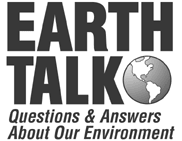
Dear EarthTalk:
How do I know if what I am buying is genuinely organic?
--Michael Faber, Acton, MA
"With produce and other food items, the required U.S. Department of Agriculture (USDA) certification and labeling process is stringent enough, but the USDA doesn't regulate household cleaners, body care products, and other household items, and that's where fraudulent labeling occurs," according to Craig Minowa, environmental scientist at the Organic Consumer Association. He says that consumers need to be careful when shopping for organic goods because companies currently add minimal or questionable organic ingredients to traditional toxics so they can market the product as "all natural" or "100% organic." One such trick involves the use of hydrosols, which are a byproduct of distilling organic plant matter and making essential oils. Companies are capturing the steam created in this process and using it in place of regular water as the base of products, allowing them to claim that a large percentage of the product is organic. "The use of hydrosols a big loophole in organic standards right now," says Minowa. "They're used to inflate organic labeling percentages."
Product labeling has also made headlines lately because of the controversy surrounding genetically modified organisms (GMOs). A bill to require labeling of such food, sponsored by Ohio Representative Dennis Kucinich is feared to not make it passed Congress. However, GMO labeling in other countries is taking off. Regarding food labeling in this country, in addition to USDA certification, there a voluntary labeling program created by the National Organic Standard Board. Their standards prohibit the use of genetically modified organisms, irradiation, sewage sludge, or antibiotics in organic meat and poultry production, and require 100-percent organic feed for organic livestock. There are three different labels, based on the percentage of organic ingredients in a product: "100 Percent Organic"; "Organic" (contains at least 95 percent organic ingredients by weight, excluding water and salt); "Made with Organic" (contains between 70 to 95 percent organic ingredients). To help consumers, the USDA has designed a seal that can be used on products labeled as "100 Percent Organic" or "Organic."
Organic labels are popping up everywhere for other types of products, but buyer beware: just because your T-shirt is made of certified organic cotton, doesn't mean that it was treated with chemical-free, organic dyes. Sandra Marquardt, project coordinator for the Organic Trade Association's (OTA) Organic Fiber Council, says that while certification for organic cotton already exists, the OTA is in the final stages of developing organic fiber processing standards that would address the treatment and dyeing of organic cotton.
CONTACT: : Organic Consumers Association, 6101 Cliff Estate Road, Little Marais, MN 55614, (218) 226-4164, www.organicconsumers.org; Organic Trade Association, P.O. Box 547, Greenfield, MA 01301, (413) 774-7511, www.ota.com, info@ota.com.
Dear EarthTalk:
Are digital cameras more environmentally friendly than traditional cameras?
--Ann Veddern, Mason, Ohio
Both technologies have environmental impacts. It may be counterintuitive, but your best option could be a single-use camera, often referred to as a disposable camera, according to James Blamphin, manager of environmental news and information at the Eastman Kodak Company. "The single-use camera has the highest recycling rate of any consumer product," he says. "We've turned a waste stream into a revenue stream." Since 1990, Kodak has recycled more than 750 million one-time-use cameras through its closed-loop recycling program. The polystyrene covers and viewfinders are grinded down and reprocessed into new camera components, and lense acrylic is made into toothbrushes.
Digital cameras are evolving to be more environmentally friendly, Blamphin explains. They are getting smaller; the camera body mass has been reduced by 50 percent over the last five years, requiring fewer resources. Cameras now run on fewer batteries, and faster computer downloading technology reduces energy use. Kodak and other companies, such as Cannon, have recently decided to remove lead from lenses. Kodak has also removed cadmium from sensors and mercury from displays.
Traditional cameras have gotten a bad rap primarily because of the chemicals required for photoprocessing. Since 1968, the amount of photochemicals required to develop and print one 24-exposure roll has been reduced from two quarts to three ounces‹a 96 percent reduction, and chemicals, including the silver used, can be reused, says Blamphin. He stands by his nomination of the single-use camera as the most environmentally friendly option, despite the photochemicals needed to develop pictures, because the recycling process saves resources. After seven or eight years you're going to get another camera and discard the old one anyway; a single-use camera can be recycled up to 10 times, he explains. And regarding digital technology: "Don't neglect to consider the chemistry needed for ink jet printing of digital images, and computer chip waste, which there are not well-established recycling programs for," he says.
CONTACT: Eastman Kodak Company, (800) 235-6325, www.kodak.com.
GOT AN ENVIRONMENTAL QUESTION? Send it to: EARTH TALK,
c/o E/The Environmental Magazine, P.O. Box 5098, Westport, CT 06881;
or submit your question at: www.emagazine.com, or e-mail us at: earthtalk@emagazine.com.
Previous Earthtalk questions:
Do cell phones cause cancer?
Some art supplies, like glues and markers, can be quite toxic, especially to children. Are there eco- and health-friendly alternatives out there?
Are "silver" dental fillings, which contain mercury, toxic?
